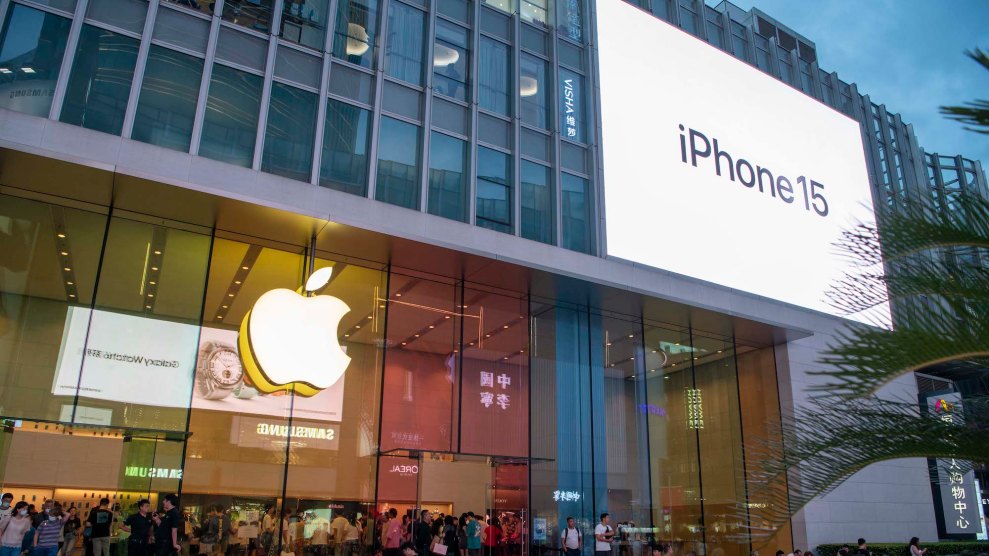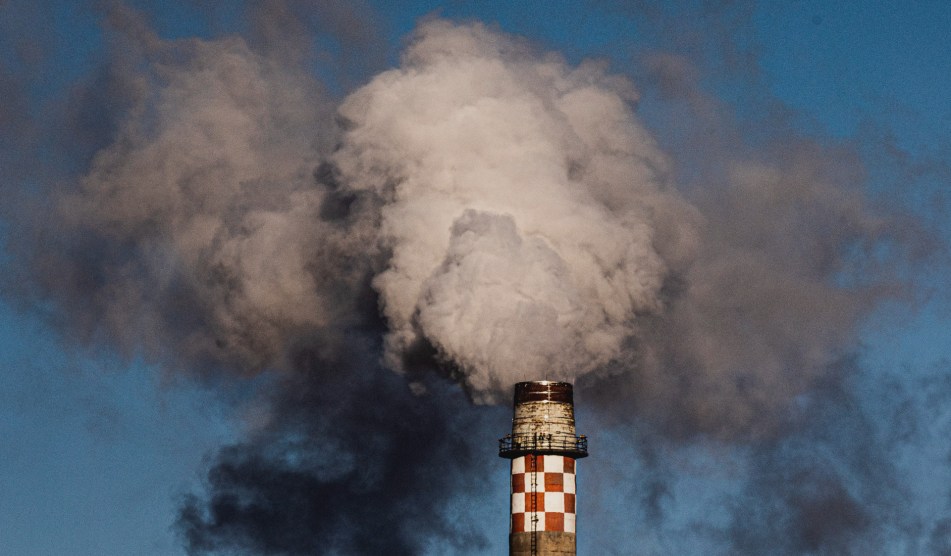
An Apple Store in Shanghai, ChinaCfoto/NurPhoto/ZUMA
This story was originally published by Inside Climate News and is reproduced here as part of the Climate Desk collaboration.
Apple’s recent announcement of its first-ever “carbon neutral” product was questioned in a new report by a Chinese environmental research organization that gathers and tracks data on greenhouse gas emissions from China’s manufacturing sector, which makes the majority of Apple products.
As part of a high profile environmental campaign including a 5-minute video featuring an approving “Mother Nature” played by actress Octavia Spencer, Apple announced on Sept. 12 that its new Apple Watch was carbon neutral, meaning its production does not contribute to climate change. But the Institute of Public and Environmental Affairs (IPE), a well-regarded nonprofit entity based in Beijing, concluded in a Sept. 22 report that the company may be “climate-washing,” or overstating its efforts to address climate change.
Apple has previously praised IPE as “a leading non-profit environmental research organization” that is “dedicated to collecting, collating, and analyzing government and corporate environmental data.” The organization has been analyzing the environmental performance of production facilities in China for more than a decade.
In response to IPE’s latest report, Apple responded that the carbon neutrality of its Apple Watch line has been independently verified by SCS Global Services, a “leader in environmental standards and certification.” “By far, the most impactful action a supplier can take to address climate change is to transition to renewable energy,” Apple said in a written statement. “That’s why we work closely with suppliers to help them procure more renewables and advocate together for reliable, cost-effective access to clean electricity in grids around the world.”
The IPE analysis concluded that Apple is not revealing enough information about suppliers who manufacture Apple products to substantiate the claim of carbon neutrality. IPE said it had received data on greenhouse gas emissions from fewer of Apple’s suppliers in 2023 than in prior years.
The report said that the company’s suppliers rely heavily on the purchase of renewable energy certificates, the efficacy of which have been called into question, rather than the direct use of renewable energy.
Apple would likely need 100 percent renewable energy to make carbon neutral watches. If the emissions profile of iPhones suddenly increased, as Apple also disclosed, one plausible explanation would be that the company allocated less renewable energy to iPhones so that it had more renewable energy to allocate to its watches, the IPE said.
“If this assumption is correct, is Apple’s carbon neutrality ‘milestone’ really a significant reduction in the carbon emissions of its product manufacturing process, or just a mathematical equation whereby Apple cherry picks the limited green electricity from its suppliers and allocate them to one relatively niche product?” the report asked.
Apple responded in a statement that it did not re-allocate renewable energy from the production of iPhones or other products to the Apple Watch. The company added that greenhouse gas emissions for its new iPhone 15 Pro are 28 percent lower than the company’s 2015 baseline, due largely to an increase in the amount of renewable energy used by their suppliers.
In 2011, IPE released two scathing investigative reports calling out Apple for its failure to disclose information about its suppliers and for the pollution those suppliers released from their factories. Following the reports, Apple disclosed more information about its suppliers and worked with them to clean up their practices. IPE has subsequently ranked Apple at or near the top of its annual “Green Supply Chain” and “Climate Action” indices.
In 2019, Apple became the first among more than 400 companies with manufacturing suppliers in China to receive IPE’s “Master” title for their outstanding green supply chain performance.
“In many years of our index assessment, Apple was one of the top performers, so we did give it credit for that, but when it started making the claim of [a] carbon neutral product, that is a very high standard and I think it needs an even higher level of disclosure,” Ma Jun, IPE’s director, said last week.
However, Ma said that the company appears to be regressing on public disclosure. He noted that fewer than 30 Apple suppliers disclosed facility level greenhouse gas emissions data to IPE in 2023, down from about 100 suppliers in prior years.
“The number has dropped at a very special moment, when carbon neutral products are being released,” Ma said.
Apple disputed the claim and said many of its suppliers publicly disclose their greenhouse gas emissions data, and Apple encourages them to do so.
“We strongly support climate disclosures to improve transparency and drive progress in the fight against climate change,” Apple said. “For the last decade, Apple has modeled, measured, and voluntarily reported our greenhouse gas emissions across all scopes of emissions, and publicly advocated for disclosure around the world. As stated clearly in our Supplier Code of Conduct, we require suppliers to report their Apple-related greenhouse gas emissions to us each year, and to comply with any laws and regulations that mandate reporting of emissions to local or national authorities.”
Joseph Romm, a senior research fellow at the University of Pennsylvania’s Center for Science, Sustainability and the Media, praised the IPE report and concurred with many of its findings.
“What exactly does it mean to say one of your products is carbon neutral” when reported emissions associated with the new iPhone 15 actually increased? Romm asked. “It seems to me to be kind of like saying your pinky is cancer free, but the rest of your body isn’t.”
Romm said Apple’s definition of carbon neutral, described in its 2023 sustainability report as reducing its emissions by 75 percent and balancing the remaining emissions with the purchase of carbon offsets, is arbitrary and less ambitious than other definitions.
He noted that the Science Based Targets initiative, a partnership that includes CDP (formerly the Carbon Disclosure Project), the United Nations Global Compact, World Resources Institute and the World Wide Fund for Nature, states that a company must first reduce direct emissions by at least 90 percent and only then can it use carbon offsets “to neutralize” at most the 10 percent of residual emissions.
Romm said that the carbon offsets that companies buy to balance out their own emissions have come under increasing scrutiny. A white paper he published earlier this year noted that many companies and events, including Delta Airlines and the 2022 FIFA World Cup in Qatar, have had their climate neutral claims challenged in court due to reliance on problematic offsets.
“A lot of companies have stopped buying offsets,” Romm said, citing recent news reports that Shell, Gucci and Nestlé all recently discontinued the practice. “Apple seems to have missed the boat, that the world is really changing here.”
The New Climate Institute, an environmental organization based in Germany, gave Apple high marks in its 2023 Corporate Climate Responsibility Monitor report but wrote in a recent blog post that the company’s carbon neutral claim for Apple Watches is “a bold exaggeration.”
A key challenge in Apple’s quest for carbon neutrality—the company’s goal is for all of its products to be carbon neutral in 2030—is manufacturing and the greenhouse gas emissions tied to the electricity its suppliers use to power their factories.
“The electricity that our manufacturing suppliers use represents the largest single source of carbon emissions throughout our manufacturing supply chain,” Apple states in its most recent sustainability report. The vast majority of Apple products are made in China, where 63 percent of the grid was powered by coal in 2022.
Apple has made substantial direct investments in renewable energy, including nearly 500 megawatts of solar and wind projects in China and Japan. The company is also widely recognized as a leader in helping its suppliers develop or purchase renewable energy to power their factories.
As of March 2023, Apple noted that “over 250 suppliers making up over 85 percent of Apple’s direct spend for materials, manufacturing, and assembly of our products worldwide have committed to using renewable electricity for their Apple production.”
However, many of Apple’s suppliers still have only limited access to renewable energy. IPE noted in its report that, based on Apple’s own reporting, 24 percent of the 250 suppliers that have pledged to use renewable energy “are unable to achieve clean energy substitution through onsite renewable electricity or renewable power purchases, etc., and need to purchase renewable energy certificates.”
Such certificates, which are intended to help fund new renewable energy development, are “unlikely to lead to additional renewable energy production” and “threaten the integrity” of corporate emission reduction targets, according to a 2022 study published in the journal Nature.
Further, some of Apple’s leading suppliers, such as Foxconn and Pegatron, report renewable energy made up just 8 percent or less of their electric power, according to a New Climate Institute assessment of the companies’ recent sustainability reports.
Recent media reports have named Foxconn as a producer of Apple’s watches, but it’s not clear what mix of renewable versus fossil energy it used in the specific factories that make those products.
While Apple said in its response to the IPE report that SCS Global Services has verified the carbon neutrality of its Apple Watch, Ma said more transparency is needed to substantiate that claim.
“Just to say that a third party has done it, that’s not sufficient,” Ma said. “Apple should be the one that needs to be held accountable for this and should provide a more transparent way for this to be verified.”













